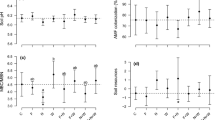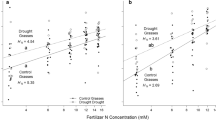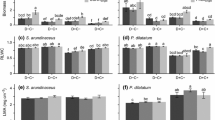Abstract
An important aspect of niche theory is the position of species’ optima along ecological gradients. It is widely believed that a species’ ecological optimum takes its shape only under competitive pressure. The ecological optimum, therefore, is thought to differ from the physiological optimum in the absence of interspecific competition. Ellenberg’s Hohenheim water table experiment has been very influential in this context. However, the water table gradient in Ellenberg’s experiment was produced by varying the soil thickness above the water table, which confounded the potentially disparate impacts of water table depth (WTD) and soil depth on species growth. Accordingly, here we have re-evaluated Ellenberg’s work. Specifically, we tested the hypothesis that physiological and ecological optima are identical and unaffected by interspecific interaction. We used the same six grasses as in Ellenberg’s experiments, but in our mesocosms, WTD was varied but soil depth kept constant. The design included both an additive component (with/without plant interaction) and a substitutive component (monocultures vs. species mixtures). The results show that the physiological optima along the hydrological gradient varied greatly between species, even in the absence of interspecific interaction. Within species, however, physiological and ecological optima appeared identical in most cases, irrespective of the competition treatment. We conclude that the ‘physiological capacity’ of species largely determines where they are able to persist and that any impact of interspecific interaction is only marginal. These findings are at variance with Ellenberg’s rule, where competition is considered to shift the distribution of a species away from its physiological optimum.



Similar content being viewed by others
References
Araya Y, Silvertown J, Gowing DJ, McConway KJ, Linder P, Midgley G (2011) A fundamental, eco-hydrological basis for niche segregation in plant communities. New Phytol 189:253–258. doi:10.1111/j.1469-8137.2010.03475.x
Austin MP, Austin BO (1980) Behaviour of experimental plant communities along a nutrient gradient. J Ecol 68:891–918. doi:10.2307/2259464
Bartelheimer M, Poschlod P (2013) The response of grassland species to nitrate versus ammonium coincides with their pH optima. J Veg Sci 25:760–770. doi:10.1111/jvs.12124
Bartelheimer M, Poschlod P (2016) Functional characterizations of Ellenberg indicator values—a review on ecophysiological determinants. Funct Ecol 30:506–516. doi:10.1111/1365-2435.12531
Bartelheimer M, Gowing DJG, Silvertown J (2010) Explaining hydrological niches: the decisive role of below-ground competition in two closely related Senecio species. J Ecol 98:126–136. doi:10.1111/j.1365-2745.2009.01598.x
Beyschlag W, Ryel RJ, Ullmann I, Eckstein J (1996) Experimental studies on the competitive balance between two Central European roadside grasses with different growth forms. Botanica Acta 109:449–455. doi:10.1111/j.1438-8677.1996.tb00597.x
Blom CWPM, Voesenek LACJ (1996) Flooding: the survival strategies of plants. Trends Ecol Evol 11:290–295. doi:10.1016/0169-5347(96)10034-3
Chase JM, Leibold MA (2003) Ecological niches: linking classical and contemporary approaches. The University of Chicago Press, Chicago & London. doi:10.7208/chicago/9780226101811.001.0001
Crawley MJ (1997) The structure of plant communities. In: Crawley MJ (ed) Plant Ecology. Blackwell Science Ltd, Oxford, pp 475–531. doi: 10.1002/9781444313642.ch14
Ellenberg H (1953) Physiologisches und ökologisches Verhalten derselben Pflanzenarten. Berichte der Deutschen Botanischen Gesellschaft 65:350–361. doi:10.1111/j.1438-8677.1953.tb00671.x
Ellenberg H (1954) Ueber einige Fortschritte der kausalen Vegetationskunde. Vegetatio 5(6):199–211. doi:10.1007/BF00299574
Ellenberg H, Düll R, Wirth V, Werner W, Paulißen D (1991) Zeigerwerte von Pflanzen in Mitteleuropa, 2nd edn. Verlag Erich Goltze KG, Göttingen
Ellert BH, Bettany JR (1995) Calculation of organic matter and nutrients stored in soils under contrasting management regimes. Can J Soil Sci 75:529–538. doi:10.4141/cjss95-075
Ernst W (1978) Discrepancy between ecological and physiological optima of plant species. A re-interpretation. Oecologia Plantarum 13:175–188
Fridley JD, Grime JP, Askew AP, Moser B, Stevens CJ (2011) Soil heterogeneity buffers community response to climate change in species-rich grassland. Glob Change Biol 17:2002–2011. doi:10.1111/j.1365-2486.2010.02347.x
Fuhlendorf SD, Smeins FE (1998) The influence of soil depth on plant species response to grazing within a semi-arid savanna. Plant Ecol 138:89–96. doi:10.1023/A:1009704723526
García-Baquero G, Silvertown J, Gowing D, Valle CJ (2016) Dissecting the hydrological niche: soil moisture, space and lifespan. J Veg Sci 27:219–226. doi:10.1111/jvs.12353
Hartmann A, Schmid M, Van Tuinen D, Berg G (2009) Plant-driven selection of microbes. Plant Soil 321:235–257. doi:10.1007/s11104-008-9814-y
Hector A, von Felten S, Hautier Y, Weilenmann M, Bruelheide H (2012) Effects of dominance and diversity on productivity along Ellenberg’s experimental water table gradients. PLoS One 7:e43358. doi:10.1371/journal.pone.0043358
Holt RD (2009) Bringing the Hutchinsonian niche into the 21st century: ecological and evolutionary perspectives. Proceedings of the National Academy of Science USA 106:19659–19665. doi:10.1073/pnas.0905137106
Hubbell SP (2001) The unified neutral theory of biodiversity and biogeography. Princeton University Press, Princeton
Hutchinson GE (1957) Cold spring harbor symposium on quantitative biology. Concluding remarks 22:415–427
Jackson RB, Canadell J, Ehleringer JR, Mooney HA, Sala OE, Schulze E-D (1996) A global analysis of root distributions for terrestrial biomes. Oecologia 108:389–411. doi:10.1007/BF00333714
Keddy PA (1992) Assembly and response rules: two goals for predictive community ecology. J Veg Sci 3:157–164. doi:10.2307/3235676
Kenkel NC, McIlraith AL, Burchill CA, Jones G (1991) Competition and the response of three plant species to a salinity gradient. Can J Bot 69:2497–2502. doi:10.1139/b91-310
Kutschera L, Lichtenegger E (1982) Wurzelatlas mitteleuropäischer Grünlandpflanzen I: Monocotyledonae. Gustav Fischer Verlag, Stuttgart
Lortie CJ, Brooker RW, Choler P, Kikvidze Z, Michalet R, Pugnaire FI, Callaway RM (2004) Rethinking plant community theory. OIKOS 107:433–438. doi:10.1111/j.0030-1299.2004.13250.x
Martorell C, Almanza-Celis CA, Pérez-García EA, Sánchez-Ken JG (2015) Co-existence in a species-rich grassland: competition, facilitation and niche structure over a soil depth gradient. J Veg Sci 26:674–685. doi:10.1111/jvs.12283
McConnaughay KDM, Bazzaz FA (1991) Is physical space a soil resource? Ecology 72:94–103. doi:10.2307/1938905
McKane RB, Johnson LC, Shaver GR, Nadelhoffer KJ, Rastetter EB, Fry B, Biblin AE, Kielland K, Kwiatkowske BL, Laundre JA, Murray G (2002) Resource-based niches provide a basis for plant species diversity and dominance in arctic tundra. Nature 415:68–71. doi:10.1038/415068a
Meziane D, Shipley B (1999) Interacting components of interspecific relative growth rate: constancy and change under differing conditions of light and nutrient supply. Funct Ecol 13:611–622. doi:10.1046/j.1365-2435.1999.00359.x
Pavelka M, Acosta M, Marek MV, Kutsch W, Janous D (2007) Dependence of the Q10 values on the depth of the soil temperature measuring point. Plant Soil 292:171–179. doi:10.1007/s11104-007-9213-9
Pickett STA, Bazzaz FA (1978) Organization of an assemblage of early successional species on a soil moisture gradient. Ecology 59:1248–1255. doi:10.2307/1938238
Silvertown J (2004) Plant coexistence and the niche. Trends Ecol Evol 19:605–611. doi:10.1016/j.tree.2004.09.003
Silvertown J, Law R (1987) Do plants need niches? Some recent developments in plant community ecology. Trends Ecol Evol 2:24–26. doi:10.1016/0169-5347(87)90197-2
Silvertown J, Dodd ME, Gowing DJG, Mountford JO (1999) Hydrologically defined niches reveal a basis for species richness in plant communities. Nature 400:61–63. doi:10.1038/21877
Silvertown J, Araya Y, Gowing D (2015) Hydrological niches in terrestrial plant communities: a review. J Ecol 103:93–108. doi:10.1111/1365-2745.12332
Stanford G, Frere MH, Schwaninger DH (1973) Temperature coefficient of soil nitrogen mineralization. Soil Sci 115:321–323
Woodward FI, Diament AD (1991) Functional approaches to predicting the ecological effects of global change. Funct Ecol 5:202–212. doi:10.2307/2389258
Acknowledgments
The authors would like to thank Sibylle Bauer, Philipp Glaab, Stefanie Meier, Benedikt Müller, Daniel Peterlik, and Christoph Schmid for help during setup und harvest of the experiment; Ingeborg Lauer for general maintenance; and the gardeners of the Botanical Garden of Regensburg for technical support. We greatly appreciated the valuable input from discussions with Jonathan Silvertown (Open University of Milton Keynes, UK) and Richard Michalet (Université Bordeaux, France). We thank two anonymous reviewers and John Hodgson for their constructive comments that helped to improve the manuscript.
Author contribution statement
MB and PP conceived the study, MB designed and executed the experiments and analyses, and MB and PP wrote the manuscript.
Author information
Authors and Affiliations
Corresponding author
Ethics declarations
Conflict of interest
The authors declare that they have no conflict of interest.
Additional information
Communicated by Bryan Foster.
Electronic supplementary material
Below is the link to the electronic supplementary material.
Rights and permissions
About this article
Cite this article
Bartelheimer, M., Poschlod, P. Ellenberg’s water table experiment put to the test: species optima along a hydrological gradient. Oecologia 181, 1163–1172 (2016). https://doi.org/10.1007/s00442-016-3624-3
Received:
Accepted:
Published:
Issue Date:
DOI: https://doi.org/10.1007/s00442-016-3624-3




